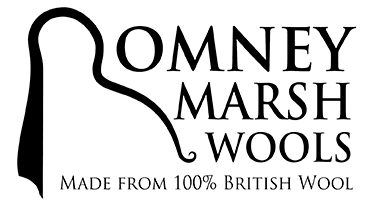Sheep on Romney Marsh
The economy and landscape of Romney Marsh in the 19th Century was dominated by sheep. Improved methods of pasture management and husbandry meant the marsh could sustain a stock density greater than anywhere else in the world. The Romney Marsh sheep became one of the most successful and important breeds of sheep. Their main characteristic is an ability to feed in wet situations; they are considered to be more resistant to foot rot and internal parasites than any other breed. Romney sheep have been exported globally, in particular to Australia, to where they were first exported in 1872.
The original Romney Marsh sheep were developed on low lying land in Kent and Sussex, adjoining the English Channel. The area was, and still is, exposed and isolated, so that a hardy breed of sheep was produced requiring the minimum of attention.
The breed expanded over the rest of the South East of England and became known as Kent Sheep. It then spread all over the world and the name Romney came into general use. The vast sheep industries of New Zealand and many other countries had their origin in the Romney sheep. For this reason, it is often referred to as ‘the best-known sheep in the world’.
It is said that the first sheep were brought to Britain by the Phoenicians sometime between 800 and 500 BC. Certainly, the Romans brought sheep with them when they invaded Britain in 43AD but it is not clear whether they had them on Romney Marsh, as Winchester was the centre of their wool industry.
Sheep have grazed the marshes for centuries, the quality of its pastures is renowned. By 14th century England’s most important commodity for internal trade and export was wool. This continued until in the 16th century when wool prices in England fell forcing traders to export more to the continent.
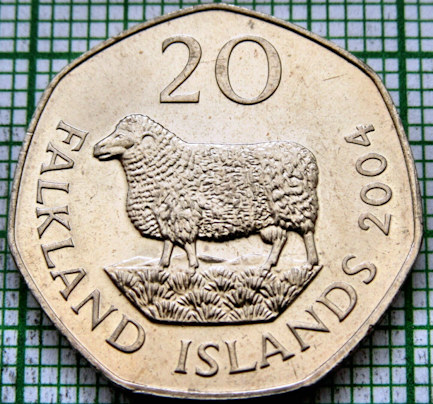

Romney Marsh Sheep on Falklands Island Coin & Stamp
But in 1660 a bill was passed preventing traders from exporting. With a long sea coast facing France there had always been a history of smuggling on Romney Marsh but the introduction of the Wool Acts of 1660 & 1699 led to an increase, especially on Romney Marshes. Incidents of smuggling continued to escalate in the 18th & 19th centuries until the government made a concerted effort to suppress it.
In l939 there were some 200,000 sheep on the marsh, but during World War II the sheep were sent away to the hill farmers in Yorkshire and the numbers of sheep on the marshes were halved, arable farming increased four-fold to 15,000 acres and this trend continues with the exception of areas that are Sites of Special Scientific Interest (SSSI) or Nature Reserves.
For centuries the raising of sheep for the wool market was the most important part of the trade of Romney Marsh. The Romney (originally called Romney Marsh) is one of the oldest known sheep breeds, with its origins having been traced back more than 700 years to the 13th Century and possibly earlier.
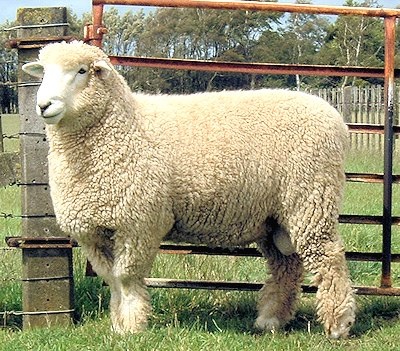
The Romney Sheep
The plague in 1346, the Black Death had a major effect on sheep farming on Romney.
History of the Romney Breed
- The Romney breed became indigenous ie native to the Romney Marsh in c 13th century.
- In the middle ages, the English woollen industry was the most important export commodity
- The Romney was recognised as a pedigree breed in England in 1896.
- The Romney is known as a “semi long-wool“ sheep, an efficient grazier with a good return on meat and wool.
- Dual purpose breed bred both for wool and meat and exported around the world.
- In the late years of the 20th century the breed was considered old fashioned, pushed aside by continental breeds.
-
Re-established their place in the 21st century farming.
The Romney sheep has the highest quality of fleece on any native British breed of sheep. The fleeces have long, crimped staples which are easy to spin and soft enough to use in the production of clothing.
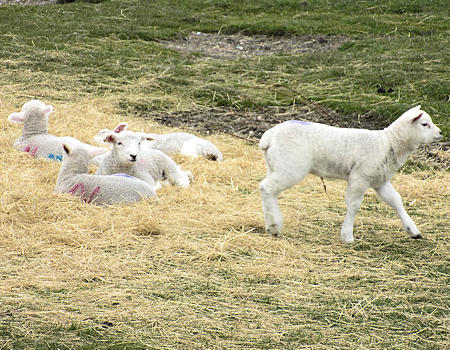
Romney Lambs
Picture of the Romney Marsh Ram taken from an old cigarette card
The text reads:
'Exceptional hardiness and adaptability to all conditions are
characteristics of this mutton breed which by careful
crossing and selection has been produced
to thrive on thecoastward
pastures of Britain.
The wool is close and good,
and the animal fattens rapidly'.
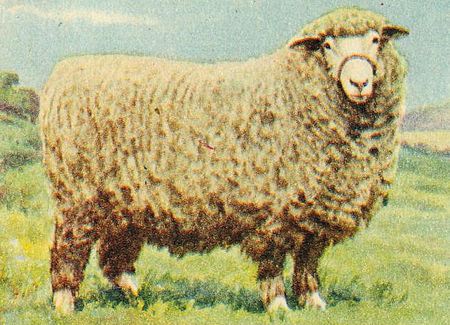
The Romney Breed
Romney sheep are a hardy and adaptable English lowland breed, being a familiar site on their indigenous areas of the Romney Marsh and lowlands of the south east coast of Kent and Sussex, England. They are a dual purpose breed, bred for both their wool and meat.
The geographic and climatic conditions on Romney Marsh led to the development of specific characteristics in the breed. These traits include black hooves resistant to footrot, resistance to internal parasites, excellent fertility and milking/mothering ability, fleeces that withstand high rainfall and a constitution that tolerates harsh, wet conditions.
Romney was developed from the native European white-faced, long-tailed sheep and took its name from the low-lying Romney Marsh area. By 1800 it was recognised as “Romney Marsh" or "Kent” and the breed’s quality improved with Leicester blood. It was recognised as a pedigree breed in 1896.
Romney Marsh sheep have white faces and a heavy fleece, and being big framed sheep they are a dual-purpose breed, providing excellent meat as well as wool. While the meat is renowned for its flavour, the fleece uniquely combines several important traits - being lustrous and hanging in separate locks. High yielding and easily spun, the wool clip from the pure-bred Romney flock is sought for many commercial products, ranging from sweaters to carpets. The fleece is also especially attractive to handspinners.
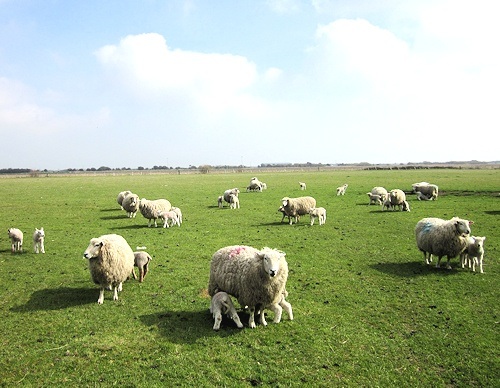
Romney Sheep and their lambs
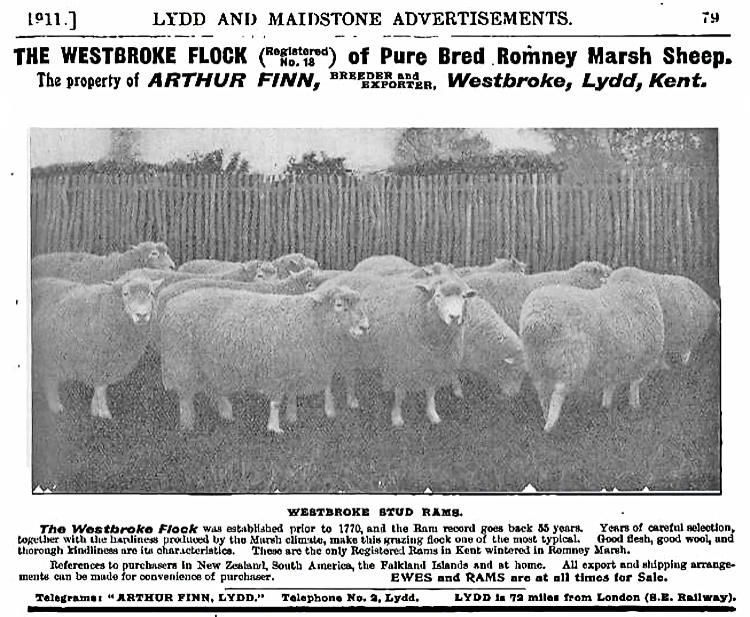
The advert reads:
"Westbroke Stud Rams
The Westbroke Flock was established prior to 1770, and the Ram record goes back 55 years.
Years of careful selection, together with the handiness produced by the Marsh climate, make this grazing
flock one of the most typical. Good flesh, good wool, and thorough kindliness are typical characteristics
These are the only Registered Rams in Kent wintered in Romney Marsh.
References to purchasers in New Zealand, South America, the Falkland Islands and at home.
All export and shipping arrangements can be made for convenience of purchaser.
EWES and RAMS are at all times for Sale"
Flocks on Romney Marsh were many times larger than those in other parts of Kent and in 1700 there were an estimated 160,000 sheep on the Marsh. Local men were employed to tend these flocks. These men became known as Lookers and are distinguished from shepherds by the fact that Lookers cared for sheep of more than one owner, whereas shepherds were normally employed by a single owner.
The Lookers lived in the villages and had to travel some distance to tend the sheep. This necessitated the construction of sheep houses, known as Lookers' Huts.
Romney Wool
Romney Wool is a natural cream colour, semi-lustrous with a long staple, often used in knitting yarns, etc. The Axminster carpet company in Devon use Romney wool in their wool carpets.
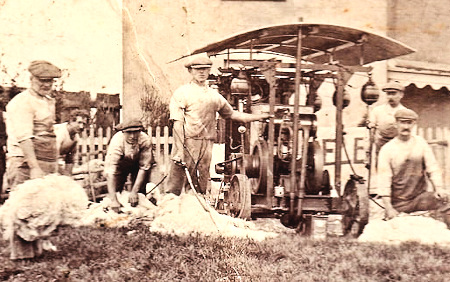
Sheep Shearing in the Past
Lanolin is a yellow waxy substance found in the sheep fleece. Lanolin's role in nature is to protect wool and skin against the ravages of climate and the environment. As a natural occurring fat in wool, it keeps the hands of sheep shearers and wool sorters so exceptionally soft.
This makes lanolin a simple and natural product for Wool Fat Soap, first produced in the early 1930’s. The soap, and related products, has many beneficial attributes, being it is gentle, rich and soothing and helps keep skin hydrated.
Wool is becoming a more popular choice as it is a renewable resource and a natural product. In Jan 2010 the Prince of Wales convened the ‘Campaign for Wool’ which aims to educate the world about the versatility and sustainability of wool. Wool represents only 5% of the Worlds Fibre production.

Woollen Industry
Romney provided the foundation for the English woollen industry, which was the most important export commodity in the Middle Ages. Their long, dense fleece was highly prized, leading to widespread wool smuggling from the 14th to the early 19th Centuries. Live sheep were exported to other continents, enabling Romney to become the world's second most economically important sheep breed and to be known as a dual purpose breed—bred for wool and meat.
Romney sheep were exported internationally early in the 19th Century when a shipment was sent to New Zealand. Today the breed is distributed throughout England, New Zealand, Australia, Patagonia, Canada, Brazil, Portugal, Falkland Islands and the United States. Hence the claim, “The sun never sets on Romney sheep.” Romneys have made an easy transition to New Zealand, where they became quickly established and still remain the predominant breed.
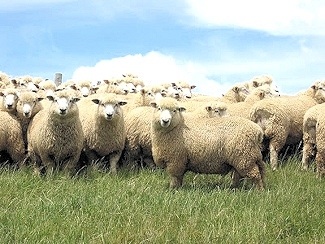
The Romney Breed in New Zealand
Local Farmers
Paul and Kristina Boulden are 6th generation family farmers on the Romney Marsh. They run a mixed farm consisting of arable farming and a suckler herd as well as their Romney flock. The sheep graze on clover-rich pasture and this plays an important role in their arable rotation.They have approximately 1000 ewes lambing in March/April.
In 2008 Paul and Kristina decided to diversify and set up Romney Marsh Wools, with the vision ‘To Capture the spirit of Romney Marsh by creating an opportunity to take home a part of history, with our quality natural wool and to pass it on from generation to generation.’
Find out more:
![]() Know Your Sheep - Romney
Know Your Sheep - Romney
![]() Monograph: Sheep-keeping and Lookers’ Huts on Romney Marsh
Monograph: Sheep-keeping and Lookers’ Huts on Romney Marsh
![]() Romney Sheep Breeders Association
Romney Sheep Breeders Association
